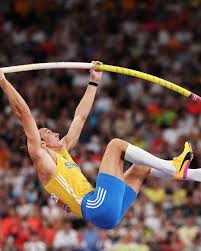Skip to content
Why world records seem to be getting harder to beat – according to maths.

New world records in some sports are remarkably elusive, yet in others they seem to fall regularly, as Armand Duplantis’s extraordinary pole vault recently demonstrated.
Looking to records in other areas such as climate change can help explain why.
To the roar of the crowd at the Athletics World Championships in Tokyo, Armand “Mondo” Duplantis sprinted down the runway with his pole aloft.

Pumping music reached a crescendo and the cheers became deafening. Then Duplantis flew.
The Swedish pole vaulter soared above the competition to assert his dominance over one of athletics’ most technical disciplines – achieving a new world record in the event.
His 6.3m (20.6ft) leap saw Duplantis win his third consecutive world title and, astonishingly, break his 14th world record. He is, in every way, raising the bar again and again.
(Read more about how Armand Duplantis is reaching new heights from BBC Sport.)

This is often what can happen in sport.
Improvements in diet, technique or equipment can bring a sudden spate of world records, especially in technical disciplines like pole‑vaulting and cycling where small adjustments make a big difference.
Technical advances in running events have also seen records tumble in recent years.

Watch: Armand Duplantis clears 6.3m to break world record
In contrast, the men’s world record in the long jump has been broken only once since 1968 when Mike Powell leapt 8.95m (29ft 4in) at the 1991 World Championships, also held in Tokyo.
Perhaps we have reached peak long jump – a situation in which further improvement is impossible and differences between an athlete’s performances come down to “luck”: the wind, how well they slept the night before, and so on.
We refer to these sorts of situations as “stationary”, in the sense that the overall trend in average behaviour is unchanging.
Given a stationary system, we can ask how often we should expect records to fall due to random fluctuations.
For an example of a stationary system on which we have long‑standing measurements, we might look to pre‑industrial climate data.

Records falling like rain
Imagine we investigate annual rainfall in different cities across the world, with the totals in each independent of the others and with no overall trend in climate behaviour.
The first year’s rainfall in each city is, by definition, a record.
If the second year’s rainfall is independent of the first, then on average, half the cities will see rainfall exceed the first year while in half it will not.
So after two years the average number of records across the cities is one plus a half.
In the third year, a total must exceed both previous years to set a new record.
On average, this happens in only one-third of the cities, so by the end of year three the expected number of records is one plus a half plus a third. And so the series continues.
After 100 years the expected number of records per city is one plus a half plus a third plus a quarter… plus a hundredth.
This set of consecutive fractions added together is known in mathematics as the Harmonic series because of its connections to harmonies in music.
It crops up in all sorts of places from stress testing in the construction industry to wartime logistics and from reliable shuffling in games of cards to the number of stickers you need to buy to complete your sticker book.
Armand Duplantis dominance in the sport of pole vaulting has turned him into a superstar (Credit: Getty Images)
Although the terms we are adding on get smaller and smaller, the sum of the harmonic series does not settle to a fixed value – but instead keeps growing.
In mathematics we say that the sequence diverges.
This agrees with our intuition about records: even in stationary systems, new records will eventually occur if we wait long enough.
But as time goes on, the growth of the sum of the harmonic series becomes very slow, as you can see in graph below.
This would mean we expect the frequency of record‑breaking to drop dramatically over time.
We expect two records in the first four years, then a wait of about seven years for the next, then around 20 years for the next, and another 52 for the one after that.
After a century we would expect roughly five records in total and after a thousand years, just seven.
As the number of events increases the number of records increases evermore slowly (Credit: Kit Yates)
Even in a stationary system we still expect records to be broken, but with decreasing frequency.
Flipping that idea on its head, we can use data on how often records fall to indicate whether a system is stationary or not.
Decades of climate data, for example, show records are being broken at an alarming rate,
suggesting our climate is rapidly warming and is no longer stationary due to the effect humans are having on the planet by emitting greenhouse gases into the atmosphere.
The rate at which record hot temperatures are being broken is declining more slowly than expected and has even started rising in the last 15 years.
Cold records, by contrast, have fallen much faster than they would in a stationary climate.
Both trends strongly indicate a warming climate.
Scientists use the ratio of actual record frequency to expected record frequency – the so-called record ratio – to characterise the extent of climate change.
In the last 15 years, the record ratio for cold events has dropped to below 0.5, suggesting cold records are being broken half as often as we might expect.
Contrastingly, by 2020 the hot record ratio had crept up above four, suggesting records are being broken four times as often as we would expect in an unchanging climate.
The hot record ratio reached 6.2 in 2024, the warmest year on record, according to the World Meteorological Organization.
Usain Bolt is still the fastest man alive with a 100m sprint record he set in 2009 still standing today (Credit: Getty Images)
What does this mean for sport?
In athletics we don’t typically have enough data to know if individual sports have reached this stationary state.
Some studies have argued that data on peak sporting performance across a range of track and field events suggest that we are at or near peak physical performance and that we should now expect records to be broken with decreasing frequency.
Others argue that human performance has yet to peak and will continue to improve.
The number of records Duplantis has smashed in recent years suggests that the technical pole vault event has likely not yet reached a stationary state.
Conversely, long-standing records suggest the long jump may already be stationary or even regressing.
We must be careful not to draw too strong a conclusion about a lack of records in a particular sport though.
The women’s long jump record has stood even longer than the men’s – Soviet athlete Galina Chistyakova leapt 7.52m (24ft 8in) in 1988.
Modern attempts at beating this record haven’t even come close.
The 100m and 200m world records set by runner Florence Griffith-Joyner in 1988 still stand today (Credit: Getty Images)
Swimming too saw a substantial drop in the rate records were being broken after the ban on high-tech polyurethane swimsuits came into effect in 2010.
The so-called “super-suits” reduced drag and increased buoyancy meaning a large number of records were broken in 2008 and 2009 when the suits were allowed, some of them standing to the present day.
That the rate of record breaking has begun to increase again suggests that improvements in technique and pool environment may allow swimmers to continue to improve for some time to come.
Sometimes, however, it can come down to extraordinary individuals who push the limits of the sport.
US swimmer Katie Ledecky has smashed 16 world records during her career and earlier this year set a new record breaking time for the 800m freestyle.
With 14 world records to his name, it is fair to say Duplantis is another athlete who is setting new standards for what is possible.
Katie Ledecky is the world’s most decorated woman swimmer (Credit: Getty Images)
But after a swelteringly hot and humid World Championships in Tokyo in 2025, World Athletics president Seb Coe acknowledged that climate change may force athletics to rethink its tradition of holding summer events.
Notably Duplantis’ was the only world record broken in Tokyo.
With three quarters of athletes reporting that climate change and heat are negatively impacting their health and competition performance, we may find that climate change itself will alter the rates at which athletics records are broken.
In the meantime, we should cherish those world records that do come along – the athletes who achieve them have beaten the odds to do something truly special.









